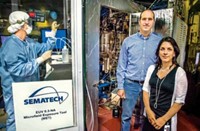Advertisement
Grab your lab coat. Let's get started
Welcome!
Welcome!
Create an account below to get 6 C&EN articles per month, receive newsletters and more - all free.
It seems this is your first time logging in online. Please enter the following information to continue.
As an ACS member you automatically get access to this site. All we need is few more details to create your reading experience.
Not you? Sign in with a different account.
Not you? Sign in with a different account.
ERROR 1
ERROR 1
ERROR 2
ERROR 2
ERROR 2
ERROR 2
ERROR 2
Password and Confirm password must match.
If you have an ACS member number, please enter it here so we can link this account to your membership. (optional)
ERROR 2
ACS values your privacy. By submitting your information, you are gaining access to C&EN and subscribing to our weekly newsletter. We use the information you provide to make your reading experience better, and we will never sell your data to third party members.
Materials
Photonics
Intel, UCSB develop hybrid laser
by Alexander H. Tullo
September 25, 2006
| A version of this story appeared in
Volume 84, Issue 39

Researchers from Intel Corp. and the University of California, Santa Barbara, have constructed the first electrically powered laser made with a silicon-based process akin to the one used in conventional semiconductor fabrication. Intel says the development is a big step in its effort to develop high-speed photonic interconnects for data centers and computers.
To assemble the laser, Intel and UC Santa Barbara used oxygen plasma to create an oxide layer that fuses together light-emitting indium phosphide, commonly used to make lasers in communications systems, and a silicon-based waveguide.
Photonic interconnects would be faster and generate less heat than copper wire, the present technology for connecting silicon chips inside computers. To date, however, making lasers individually and aligning them on silicon chips has been cost-prohibitive. Intel says its use of familiar processes may lower costs enough to enable greater incorporation of photonics in computing.
Intel says the technology will not be ready for market for another five years. Applications could include servers, data centers, and, eventually, desktop computers and laptops. "This could bring low-cost, terabit-level data pipes inside future computers and help make possible a new era of high-performance computing applications," says Mario Paniccia, director of Intel's Photonics Technology Lab. "We believe dozens, maybe even hundreds, of hybrid silicon lasers could be integrated with other silicon photonic components onto a single chip."
According to Karen Liu, an optical components consultant with U.K.-based Ovum, Intel has taken a leadership role in developing silicon photonics. "It has been pushing for some time now with a vision of low-cost silicon options targeting the need for optical interconnects," she says. Intel's breakthrough could have far-reaching consequences, Liu adds, but she cautions that "it is too early to know if this is a solution."






Join the conversation
Contact the reporter
Submit a Letter to the Editor for publication
Engage with us on Twitter